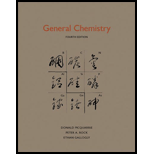
Concept explainers
Interpretation:
The freezing points of wine and vodka have to be calculated.
Concept Introduction:
Freezing point depression:
The lowering of the vapor pressure of a solvent by a solute leads to a lowering of the freezing point of the solution relative to that of the pure solvent. This effect is called as the freezing point depression. The mathematical relationship is given below.
Where,
Answer to Problem 16.70P
The freezing points of wine and vodka are
Explanation of Solution
The value of
Wine and vodka are about
Given that, the densities of ethanol and water are
The mass of ethanol and water in wine and vodka can be calculated as given below.
The colligative molality of wine and vodka can be calculated as given below.
The colligative molality and molality are same for ethanol.
Now, using the freezing point depression expression, the freezing points of wine and vodka can be calculated.
For wine:
For vodka:
The value of
Therefore, the freezing points of wine and vodka are
Want to see more full solutions like this?
Chapter 16 Solutions
General Chemistry
 ChemistryChemistryISBN:9781305957404Author:Steven S. Zumdahl, Susan A. Zumdahl, Donald J. DeCostePublisher:Cengage Learning
ChemistryChemistryISBN:9781305957404Author:Steven S. Zumdahl, Susan A. Zumdahl, Donald J. DeCostePublisher:Cengage Learning ChemistryChemistryISBN:9781259911156Author:Raymond Chang Dr., Jason Overby ProfessorPublisher:McGraw-Hill Education
ChemistryChemistryISBN:9781259911156Author:Raymond Chang Dr., Jason Overby ProfessorPublisher:McGraw-Hill Education Principles of Instrumental AnalysisChemistryISBN:9781305577213Author:Douglas A. Skoog, F. James Holler, Stanley R. CrouchPublisher:Cengage Learning
Principles of Instrumental AnalysisChemistryISBN:9781305577213Author:Douglas A. Skoog, F. James Holler, Stanley R. CrouchPublisher:Cengage Learning Organic ChemistryChemistryISBN:9780078021558Author:Janice Gorzynski Smith Dr.Publisher:McGraw-Hill Education
Organic ChemistryChemistryISBN:9780078021558Author:Janice Gorzynski Smith Dr.Publisher:McGraw-Hill Education Chemistry: Principles and ReactionsChemistryISBN:9781305079373Author:William L. Masterton, Cecile N. HurleyPublisher:Cengage Learning
Chemistry: Principles and ReactionsChemistryISBN:9781305079373Author:William L. Masterton, Cecile N. HurleyPublisher:Cengage Learning Elementary Principles of Chemical Processes, Bind...ChemistryISBN:9781118431221Author:Richard M. Felder, Ronald W. Rousseau, Lisa G. BullardPublisher:WILEY
Elementary Principles of Chemical Processes, Bind...ChemistryISBN:9781118431221Author:Richard M. Felder, Ronald W. Rousseau, Lisa G. BullardPublisher:WILEY





